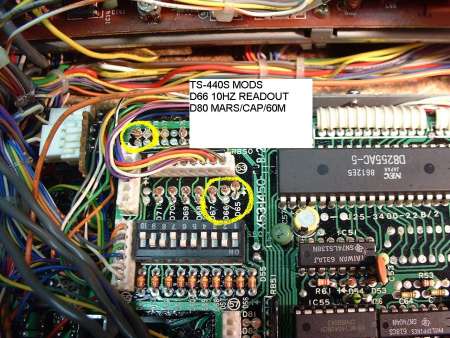The TS440 is nice. Here's what I've found out about it that isn't in
the operation manual (in some random order):
Diode options: There are a bunch of configuration options controlled by
clipping or inserting diodes on the back of the control board. You get
to it by taking the top and bottom covers off (a bunch of silver
screws), loosening the front panel (4 flat-head silver screws, NOT the
black ones). Then you have:
diode controls in out (cut)
----- -------- ---------- ----------
D65 mode confirmation Morse single beep
D66 display resolution 100 Hz 10 Hz
D67 memory protect none on
D73 CW shift 800 Hz 400 Hz
D78 WARC 24MHx band tx disabled enabled
D79 WARC 18MHz band tx disabled enabled
D80 General Coverage tx disabled enabled

Self-Test: You can run a rather complete test of the control logic by
the built-in "semi-self-test", a series of 56 routines. To run this,
turn the unit on whilst holding the AM and T-F SET switches pushed in.
It changes to the next test when you turn the VFO knob clockwise. Turn
the power OFF to reset the unit.
Test What it does
---- ---------------------------------------------------
0 all positions in display light
1 all segments in display dark
2 all positions in display light
3 all segments in display dark
4 one digit lighted (rightmost)
5 next digit lighted
6 next digit lighted
7 next digit lighted
8 next digit lighted
9 next digit lighted
10 next digit lighted
11 next digit lighted
12 next digit lighted
13 next digit lighted
14 next digit lighted
15 next digit lighted
16 next digit lighted (leftmost)
17 beeper sounds
18 beeper silent
19 all mode LEDs ON
20 all mode LEDs OFF
21 receive
22 transmit
--------------------------------------------------------------------------
The following tests change internal signals. They are most useful if
you are trying to trace the circuits controlled by these signals.
You'll need a s service manual (or at least a schematic) to made reals
sense of these.
23 Band select - all lines high
24 BAND select - all lines low
25 PD select - all lines high
26 PD select - all lines low
27 ENF select - all lines high
28 ENF select - all lines low
29 ENP select - a:ll lines high
30 ENP select - all lines low
31 RES select - all lines high
32 RES select - all lines low
33 CO select - all lines high
34 CO select - all lines low
35 AX select - all lines high
36 AX select - all lines low
these next tests check the outputs of the 8255 parallel port interfaces,
which select several internal functions.
37 (IC2) port A all lines high
38 (IC2) port A all lines low
39 (IC2) port B all lines high
40 (IC2) port B all lines low
41 (IC2) port C0-C3 high, C4-C7 low
42 (IC2) port C0-C3 low, C4-C7 high
43 (IC53) port C all lines high
44 (IC53) port C all lines low
Following display busy lines and scan lines in the rightmost 9 digits of
the display. You will push buttons to cause the digit to change from a
1 to a 0 indicating that the associated button has been pushed.
test bit8 bit7 bit6 bit5 bit4 bit3 bit2 bit1 bit0
---- ---- ---- ---- ---- ---- ---- ---- ---- ----
45 LOCK AT Mic UP Mic DN PTT/AT VS1
46 (none)
47 (key scanner)
48 1 6 V/M VOICE
49 2 7 M>V RIT A/B
50 3 8 SCAN XIT SPLIT
51 4 9 M.IN T-Fset A=B dip3 dip4 dip5
52 5 0 CLEAR 1Mhz dip1 dip2 dip6 dip7
53 ENT DOWN UP dip8 dip9 dip10
(the digits 0-9 are on the front panel keyboard; dip2-dip10 are the
segments of S50, the SSB frequency response dipswitch on the rear of the
control unit printed circuit board.)
54 not used
55 not used
56 END
|
